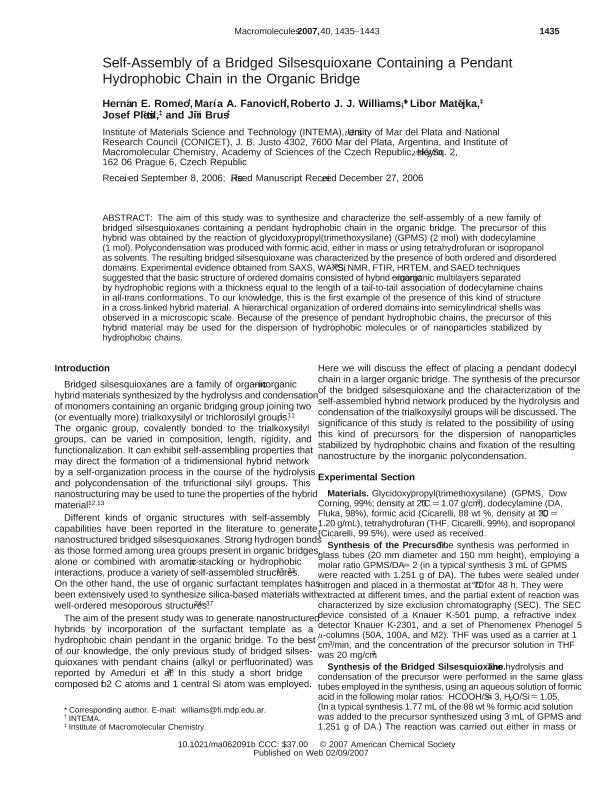Artículo
Self-assembly of a bridged silsesquioxane containing a pendant hydrophobic chain in the organic bridge
Romeo, Hernan Esteban ; Fanovich, Maria Alejandra
; Fanovich, Maria Alejandra ; Williams, Roberto Juan Jose
; Williams, Roberto Juan Jose ; Matějka, Libor; Pleštil, Josef; Brus, Jiří
; Matějka, Libor; Pleštil, Josef; Brus, Jiří
 ; Fanovich, Maria Alejandra
; Fanovich, Maria Alejandra ; Williams, Roberto Juan Jose
; Williams, Roberto Juan Jose ; Matějka, Libor; Pleštil, Josef; Brus, Jiří
; Matějka, Libor; Pleštil, Josef; Brus, Jiří
Fecha de publicación:
03/2007
Editorial:
American Chemical Society
Revista:
Macromolecules
ISSN:
0024-9297
Idioma:
Inglés
Tipo de recurso:
Artículo publicado
Clasificación temática:
Resumen
The aim of this study was to synthesize and characterize the self-assembly of a new family of bridged silsesquioxanes containing a pendant hydrophobic chain in the organic bridge. The precursor of this hybrid was obtained by the reaction of glycidoxypropyl(trimethoxysilane) (GPMS) (2 mol) with dodecylamine (1 mol). Polycondensation was produced with formic acid, either in mass or using tetrahydrofuran or isopropanol as solvents. The resulting bridged silsesquioxane was characterized by the presence of both ordered and disordered domains. Experimental evidence obtained from SAXS, WAXS, 29Si NMR, FTIR, HRTEM, and SAED techniques suggested that the basic structure of ordered domains consisted of hybrid organic-inorganic multilayers separated by hydrophobic regions with a thickness equal to the length of a tail-to-tail association of dodecylamine chains in all-trans conformations. To our knowledge, this is the first example of the presence of this kind of structure in a cross-linked hybrid material. A hierarchical organization of ordered domains into semicylindrical shells was observed in a microscopic scale. Because of the presence of pendant hydrophobic chains, the precursor of this hybrid material may be used for the dispersion of hydrophobic molecules or of nanoparticles stabilized by hydrophobic chains.
Palabras clave:
Silsesqioxanes
,
Hybrid Materials
Archivos asociados
Licencia
Identificadores
Colecciones
Articulos(INTEMA)
Articulos de INST.DE INV.EN CIENCIA Y TECNOL.MATERIALES (I)
Articulos de INST.DE INV.EN CIENCIA Y TECNOL.MATERIALES (I)
Citación
Romeo, Hernan Esteban; Fanovich, Maria Alejandra; Williams, Roberto Juan Jose; Matějka, Libor; Pleštil, Josef; et al.; Self-assembly of a bridged silsesquioxane containing a pendant hydrophobic chain in the organic bridge; American Chemical Society; Macromolecules; 40; 5; 3-2007; 1435-1443
Compartir
Altmétricas



